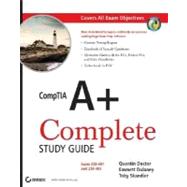Candidates aiming for CompTIA's revised, two-exam A+ Certified Track will find everything they need in this value-packed book. Prepare for the required exam, CompTIA A+ Essentials (220-601), as well as your choice of one of three additional exams focusing on specific job roles--IT Technician (220-602), Remote Support Technician (220-603), or Depot Technician (220-604). This in-depth book prepares you for any or all four exams, with full coverage of all exam objectives. Inside, you'll find:
- Comprehensive coverage of all exam objectives for all four exams in a systematic approach, so you can be confident you're getting the instruction you need
- Hand-on exercises to reinforce critical skills
- Real-world scenarios that show you life beyond the classroom and put what you've learned in the context of actual job roles
- Challenging review questions in each chapter to prepare you for exam day
- Exam Essentials, a key feature at the end of each chapter that identifies critical areas you must become proficient in before taking the exams
- A handy fold-out that maps every official exam objective to the corresponding chapter in the book, so you can track your exam prep objective by objective
- Look inside for complete coverage of all exam objectives for all four CompTIA A+ exams.
Featured on the CD
SYBEX TEST ENGINE:
Test your knowledge with advanced testing software. Includes all chapter review questions and 8 total practice exams.
ELECTRONIC FLASHCARDS:
Reinforce your understanding with flashcards that can run on your PC, Pocket PC, or Palm handheld.
Also on CD, you'll find the entire book in searchable and printable PDF. Study anywhere, any time, and approach the exam with confidence.
Visit www.sybex.com for all of your CompTIA certification needs.
Note: CD-ROM/DVD and other supplementary materials are not included as part of eBook file.








